Star Renegades is a strategy RPG about a scrappy group of misfits, outlaws, and psychopaths waging a desperate and endless war with an interdimensional army called the Imperium. A typical conquering empire ruled by a tyrannical artificial intelligence called MOTHER, the Imperium invades neighboring dimensions to add them to its totalitarian collective. By destroying Titan cores on specific worlds that act as keystones holding the Imperium’s prime dimension at bay, it brings entire universes under its heel.
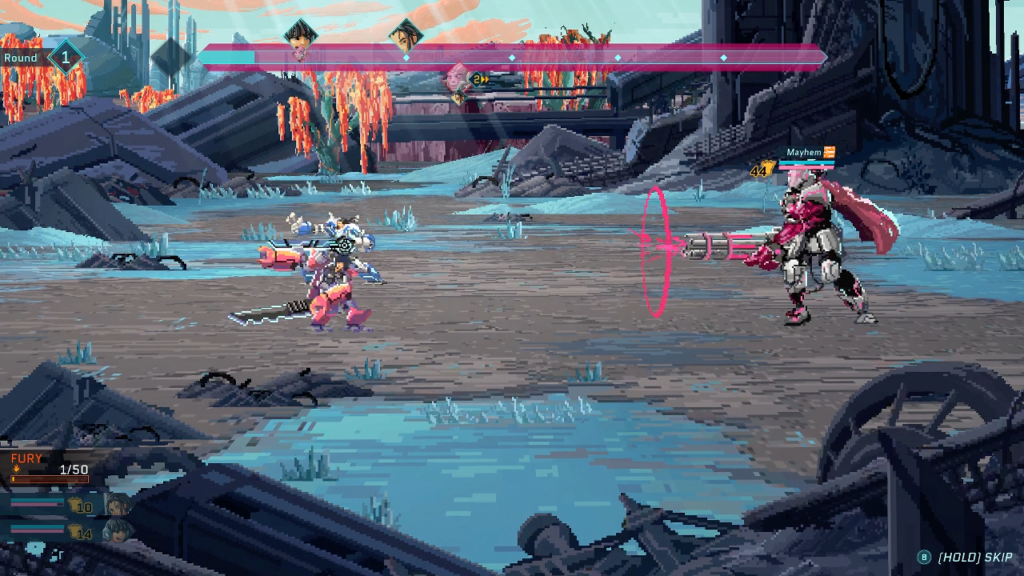
Hope comes in the form of J5T-1N, a probe created to travel ahead of the Imperium’s interdimensional warpath to warn the next target. In each new dimension, JST-1N gathers a resistance to protect the Titan cores from the Imperium’s surgical strike force. If the resistance succeeds, their dimension is saved. If they fail, the entire Imperium army pours in and their home is added to the regime. In either case, the war continues. There’s always another dimension for the eternal Imperium to conquer and another band of Star Renegades to stand against them.
Nearly all of my time in Star Renegades is spent in strategic turn-based RPG battles. Utilizing each Renegade’s specialized skills, I engage Imperium squads dotted across small procedurally generated maps. I win a battle by reducing the entire enemy squad to zero hit points using different attacks and supporting abilities. I lose if they reduce all my team’s hit points to zero first. In order to succeed I must field a team with complementary skill sets.
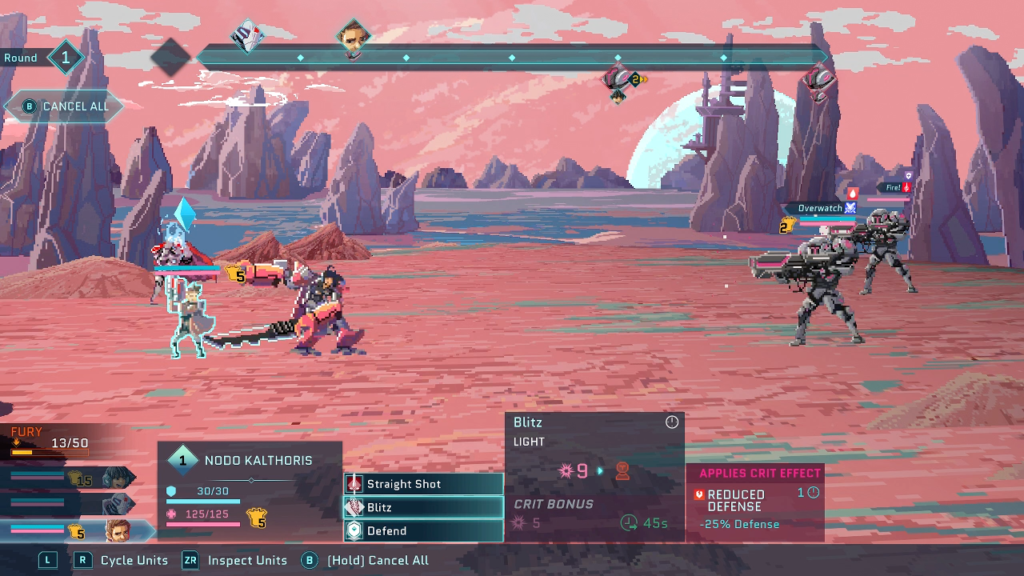
The default squad in my first mission is a good example of how the different classes play off each other. The Valkyrie is a tough Renegade who can sit on the front row to absorb attacks that would cripple her more frail allies while still dealing good damage with her hard-hitting attacks. The Archon is a strong supporting character. Though his attacks are weak, he has the invaluable ability to restore his allies’ shields each turn. Third is the Saboteur, whose skill set is the most important of the starting trio. His laser pistol isn’t as powerful as the Valkyrie’s sword, but all his abilities delay when his targets take their turns. This ability to influence when Imperium forces are able to act is the most important aspect of Star Renegades.
Every action used by both factions has a different speed. Each turn, the enemy team locks in the actions they will perform and I am allowed to choose my team’s actions in response. Only after I have locked in all of my team’s actions will the turn unfold. Actions that strike a target before it executes an action will be critical hits, dealing extra damage and varying additional effects. The most notable is knocking the target’s action further back in the turn. If I knock an action back far enough, it will Break the target, delaying their action until the next turn. Most of the strategy comes from using my team’s abilities to minimize the damage they take. Going all-out is a good way to die. Instead, I must selectively eliminate the enemies I can and Break the ones I can’t.
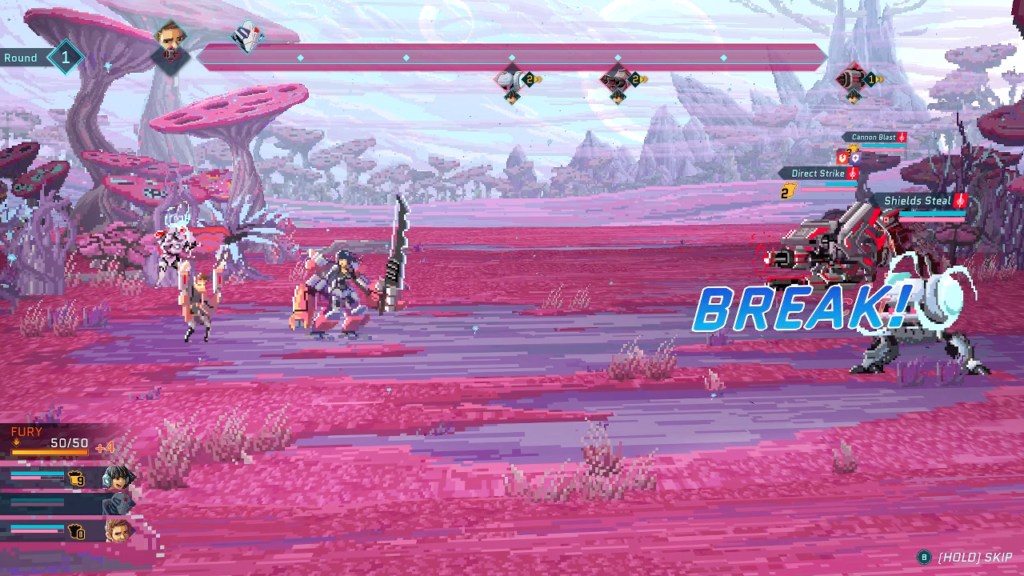
Breaking is most useful when it lets the damage-focused Renegades unleash their full potential. The Valkyrie’s Cleave skill is powerful, but slow. It leaves her vulnerable to critical hits and doesn’t deal its full damage if it strikes after the target’s action. But if the target Breaks, Cleave and every other powerful attack in my team’s arsenal can be unloaded onto it at once for maximum effect.
There are always times where I cannot kill or Break everyone in the enemy squad. This is where I must take into account the different vitality attributes each Renegade has. Every one has both shields and health. Shields are the first to drain from most sources of damage, can be regenerated mid-battle using different abilities and equipment, and fully recover after every battle. When a Renegade’s shields are completely depleted, they lose health instead. Health damage persists until I either use rare healing resources between battles or finish the current planet. A few Renegades also possess armor, which reduces the damage taken to their health pools by an amount equal to their armor rating. A high armor rating can negate much of an attack’s damage, but it can be reduced by critical hits and, much like health, must be restored using rare resources.
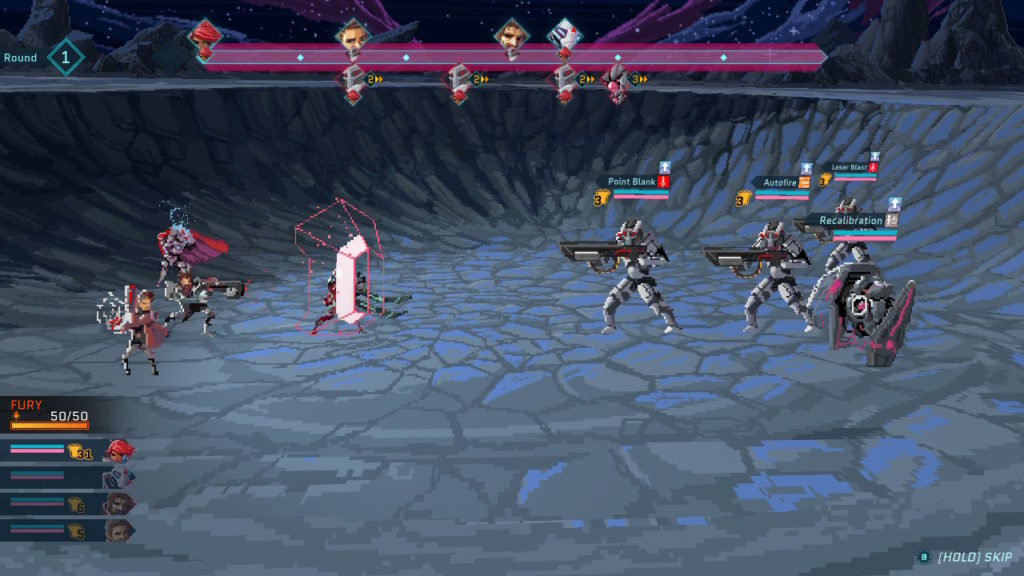
Some Renegades are better at taking damage than others, possessing larger vitality pools and abilities which reduce or alter the damage they take. These assume the traditional tank role of an RPG hero squad. Frustratingly, I do not begin Star Renegades with a tank available. The Valkyrie works in a pinch but is far more effective as a damage dealer. Soon I have access to the Aegis, who has powerful shields and can choose to take damage in place of another Renegade. It is an Aegis that leads me to my first victory against the Imperium. Other, more unorthodox tanks can be unlocked as well. These include the Berserker, who can taunt enemies into targeting her, has high armor to shrug off the majority of the damage to her health pool, and recharges her allies’ shields each time she is hit.
My goal in most turns is to use a tank to get the heat off the rest of the squad, disruptors to Break whatever targets I can, and finish up with slow, powerful abilities from damage dealers to decimate the enemy squad. Executing this strategy is relatively simple at a campaign’s start. I only have three Renegades on my team and they face three or fewer Imperium soldiers at a time. Strategies become steadily more complicated over each campaign’s course as I add new Renegades to my team and Imperium squads become larger and larger. Simple fights with obvious decisions that take seconds to win grow into protracted battles filled with logic and sacrifice that take over ten minutes to complete at the extreme end.
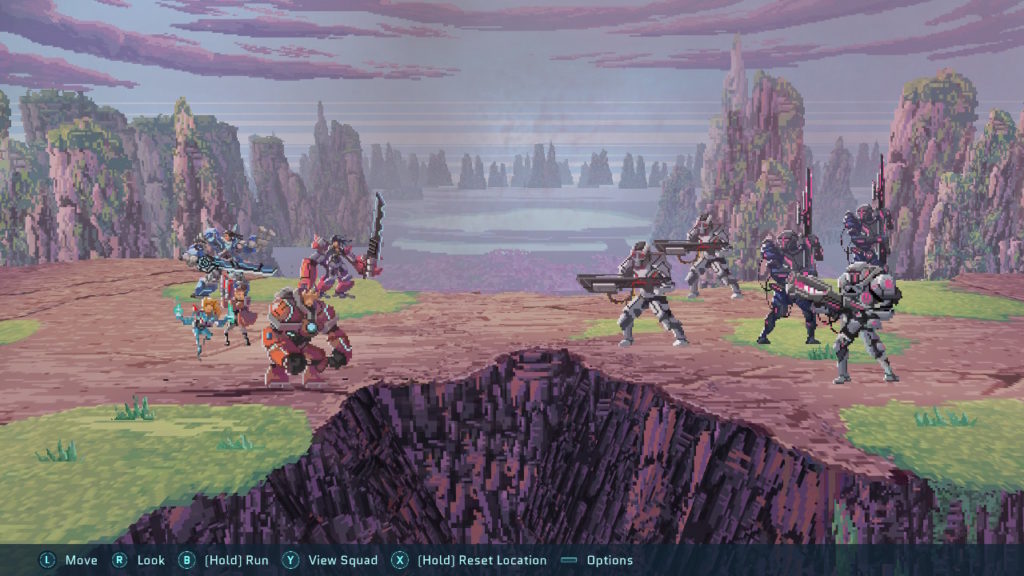
Success in these battles requires concentration, knowledge of both the Renegades’ and the Imperium’s skills, and improvising new plans when the tried-and-true inevitably fails. It’s common to begin a turn with a giant red warning symbol on a fragile Renegade, indicating they will die that turn. That turn becomes a puzzling scramble to save them since the precariously balanced matchups means losing one Renegade ensures the others will quickly follow.
This is especially true against Officers, more powerful versions of Imperium soldiers who bring unique traits to the battlefield. Some of them can become Enraged, responding to debuffs or specific actions by increasing the speed and power of their attacks. Others recover shields, health, or armor every turn. Still others have traits as devastatingly mundane as always dealing extra damage or adding an additional soldier to their squad.
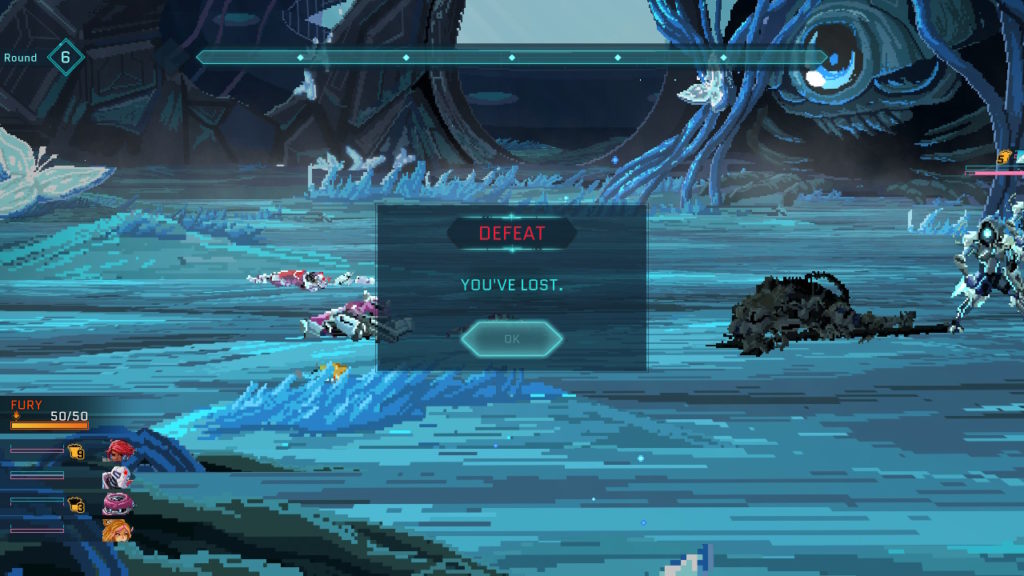
There is no escape from Imperium Officers. Due to their multidimensional nature, Officers I fail to kill during a campaign will appear in the next. Worse, ones who wipe out my team gain a promotion and reappear in the next dimension with even more enhanced abilities. Yes, an Imperium Officer who was already too strong to overcome becomes even stronger the next time I encounter them, requiring tighter strategy and sometimes outright luck to defeat. There are times where killing one troublesome Officer feels like a bigger goal than making it through the entire campaign. Worse yet, these Officers have an annoying habit of getting resurrected in future campaigns. They sell the futile struggle against the endless Imperium, though at the cost of their sheer power sometimes feeling exasperating.
Star Renegades’ battles are difficult, especially when facing off with groups led by an Officer, but I find the more I play and learn about each Renegade and how they synergize with their teammates, I was more and more successful on each attempt. My growing mastery is countered by new difficulty levels that increase the damage my team takes, though attempting these challenges is entirely up to me. The default difficulty level feels enough. Going any further is showing off.
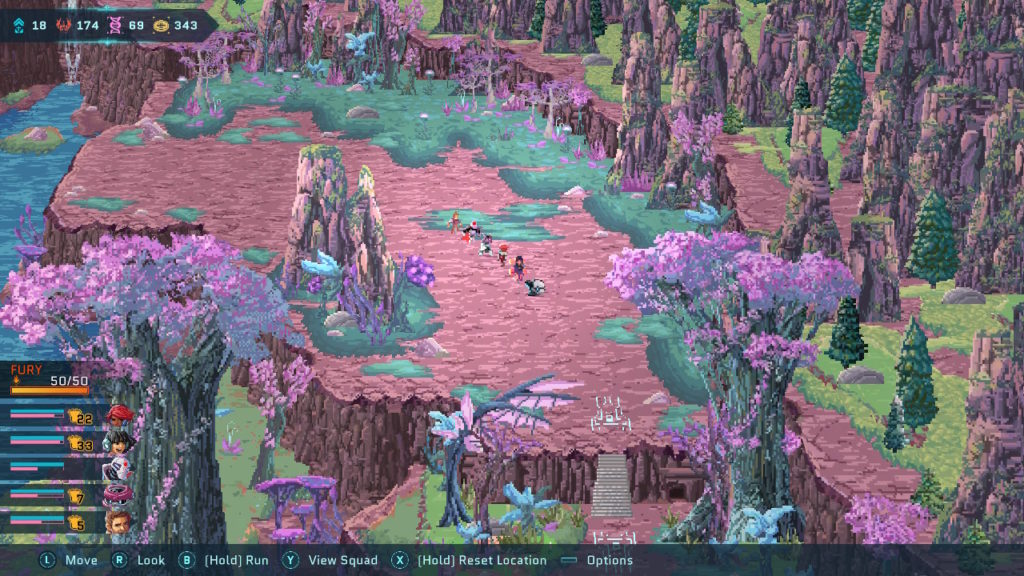
In between battles I make strategic choices on a map screen representing the planets the Renegades must protect. The map is divided into large quadrants, and I can enter up to three of them a day. In addition to Imperium forces spread across the quadrants, I can also access chests containing equipment to boost my team’s skills and stations that restore their health and armor. Some quadrants contain side dungeons where I can acquire additional experience levels, rare equipment, and upgrades. Seeking these side areas out is essential, as Imperium squads gradually outlevel my Renegades if I don’t squeeze as many experience levels out of each map as I can.
After I’ve moved through three quadrants, the team camps for the night. In a scene that feels inspired by Darkest Dungeon, I can use each Renegade’s abilities to heal their partner’s health or improve the damage they deal in the coming battles. After three nights, I fight the planet’s boss. If I can successfully repeat this loop across three planets, I travel to the Imperium’s mothership where I battle their Overseer. Defeating them stops the Imperium incursion into that dimension for good.
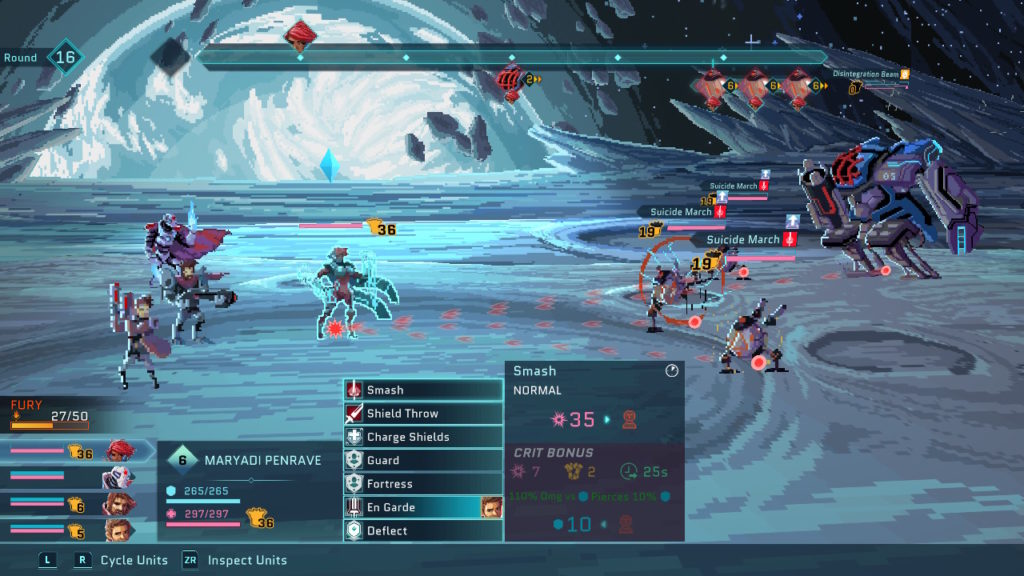
This rigid campaign structure plagues Star Renegades with a repetitious malaise. Every time I follow J5T-1N to a new dimension, I know I will face the same Imperium forces on the same planets. At the end of each planet, I fight the same boss. When I find the portal that transports me to a side dungeon on the Moon, it always ends with a boss battle against a bomb-laying automaton called the Destroyer. The other side dungeons don’t get bosses at all, instead culminating in a powered-up squad of regular Imperium soldiers. There are almost a dozen variations of the Overseer boss to face at each mission’s end, but they all feel like variations on a theme, employing the same tactics with differing abilities. I do unlock an alternate second planet after my first victory, but this is the sole injection of new life into the campaign I found in almost sixty hours of play.
What keeps Star Renegades engaging whether I am losing to an early difficulty curve or prevailing against its reliance on the same few strategies is its macrogame. Whether a campaign ends in defeat or victory, J5T-1N is transported to the Renegades’ base where I can spend a few minutes spending earned credits.
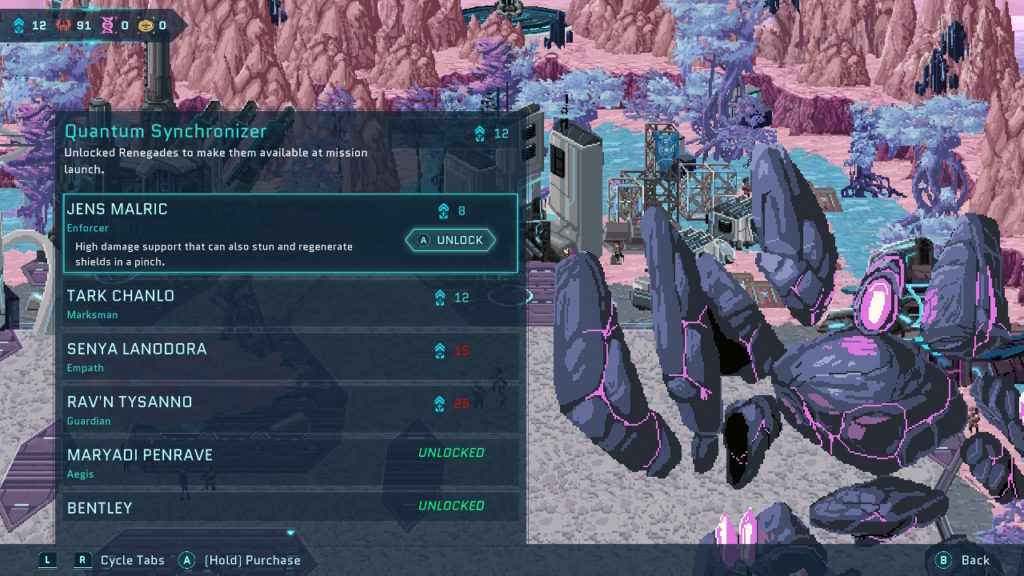
Everything I kill gives a token which can be spent in an armory on new weapons, shields, and tech upgrades I may encounter in the next campaign. Defeated Officers and bosses also award Intel which unlock new Renegades to add to my teams and multiple specialized classes for each of them. J5T-1N adds this knowledge to its database as I purchase them, so I always have access to them in future dimensions. Win or lose, I come out of every campaign gaining at least some semblance of forward mobility.
While using their support abilities during the nightly campout, the Renegades also build up relationship points between an ability’s user and its target. Building these point values high enough improves their relationship along a milestone track, each milestone conferring a powerful passive bonus to their primary skill set and unlocking a short conversation between the pair that enriches their characterization and the setting.
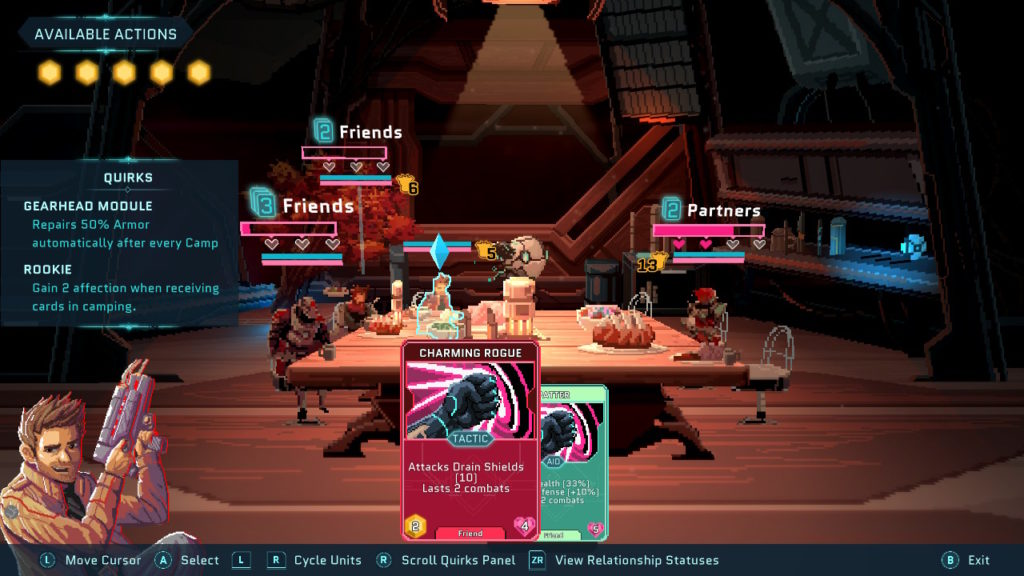
Some pairings have an extra milestone to reach and will produce Progeny when capped out, adding a new Renegade to purchase with J5T-1N at the end of the campaign. Most of these new Renegades are variations on existing ones with modified abilities and statistics, but a handful are all-new characters that add further strategic depth to the Renegade’s group dynamics. Viewing all the conversations each pairing shares and the Progeny they unlock keeps me coming back for campaign after campaign long after I have become bored with the Imperium confronting me with the same few strategies. It takes me almost sixty hours to unlock all the distinct characters, and I still have dozens more variations to go.
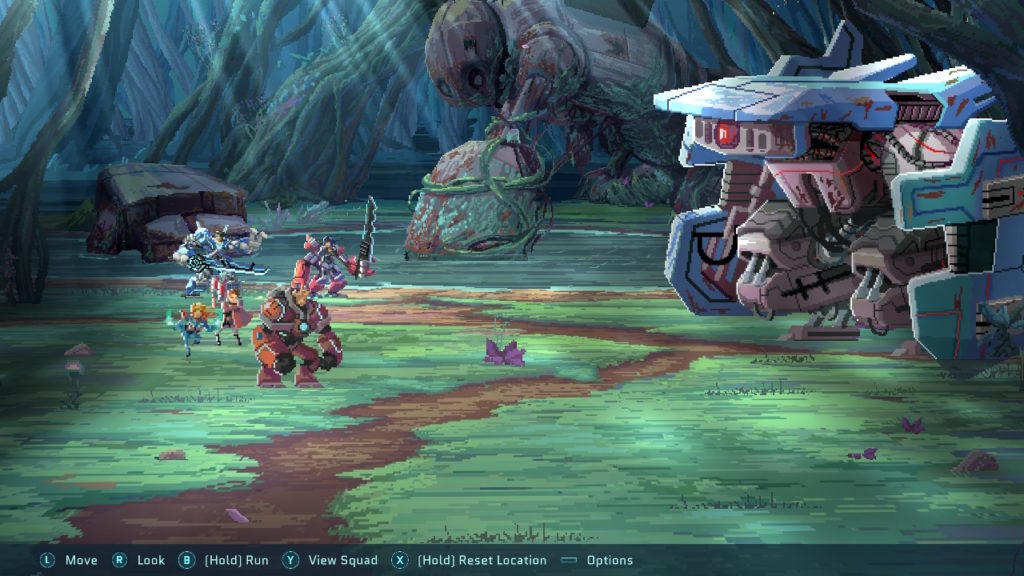
Star Renegades is a decent strategy RPG that becomes stale as the Imperium’s strategies become more and more familiar with every successive campaign. With my opponents not changing their tactics from dimension to dimension, I have to constantly switch up my own team to keep things interesting. Unlockable difficulty levels feel intended to keep things fresh, but since all they do is increase the damage the Imperium deals, it makes the experience more frustrating instead of more interesting. I am kept engaged up until the point I unlock all the distinct Progeny, but every campaign after that feels less and less necessary. It doesn’t possess the longevity to keep me involved until I’ve unlocked absolutely everything. Strategy RPG fans looking for something to pad out their libraries may have a good time, but padding is all it will be.